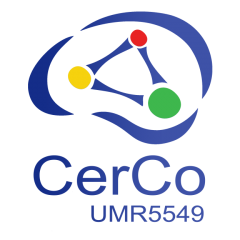Responsables: Benoit Cottereau & Jean-Baptiste Durand
L’équipe SV3M réunit des chercheurs et des cliniciens aux compétences complémentaires qui visent à mieux comprendre les mécanismes neuronaux et cognitifs qui sous-tendent la vision spatiale. Ensemble, ils ont développé une approche innovante, résolument multi-modèle (humain sain, patient, singe et machine) et trans-disciplinaire (comportement, suivi oculaire, électroencéphalographie, stimulation corticale, imagerie fonctionnelle chez les primates humains et non humains, modélisation). Le projet actuel de l’équipe explore la vision spatiale dans des conditions naturalistes, en se concentrant sur ses rôles dans la navigation (axe I), sur les mécanismes par lesquels elle acquiert la sélectivité, l’expertise et la plasticité (axe II) et sur ses interactions avec d’autres fonctions cognitives (axe III). En outre, ces trois axes alimentent un quatrième axe de recherche translationnelle fortement ancré dans les domaines clinique et technologique.
Thématiques
I. SVN : Vision et navigation spatiales (traitement du mouvement dans un environnement réaliste et dynamique, intégration multisensorielle dans un environnement réaliste et dynamique)
2. CMSV : Computational Models of Spatial Vision (modélisation de la sélectivité et de l’expertise en matière de vision spatiale, modélisation de la plasticité dans la vision spatiale)
3. SVC : Spatial Vision and Cognition (cognition spatiale et sociale, vision spatiale et culture)
4. SVTR : Vision spatiale pour la recherche translationnelle (applications technologiques, applications cliniques)
Chercheurs
• Robin BAURES (PU)
• Benoit COTTEREAU (DR CNRS)
• Sylvain CREMOUX (MCU)
• Jean-Baptiste DURAND (CRCN CNRS)
• Franck-Emmanuel ROUX (PUPH – Neurosurgeon)
• Alexandra SEVERAC CAUQUIL (MCU)
• Vincent SOLER (PUPH – Ophtalmologist)
• Yves TROTTER (DRE CNRS)
Doctorants
- Grégoire AUDREY
- Elise ABOU-MIRAD
- Tomas DE UDAETA
- Célia GISLOT
- Alan GUYOMARCH
- Geoffroy KEIME
- Alba LANGLADE
- Marie-Alphée LAURENT
- Solène LEBLOND
- Sarah MARCHAND
- Pierre-Marie MATTA
- Célia MICHAUD
- Ulysse RANÇON
Publications représentatives
- Baurès, R., Fourteau, M., Thébault, S., Gazard, C., Pasquio, L., Meneghini, G., … Durand, J. B. & Roux, F. E. (2020). Time‐to‐contact perception in the brain. Journal of Neuroscience Research.
- De Castro, V., Smith, A. T., Beer, A. L., Leguen, C., Vayssière, N., Héjja-Brichard, Y., … Cottereau, B. R. & Durand, J. B. (2020). Connectivity of the Cingulate Sulcus Visual Area (CSv) in Macaque Monkeys. Cerebral Cortex.
- Héjja-Brichard, Y., Rima, S., Rapha, E., Durand, J. B., & Cottereau, B. R. (2020). Stereomotion Processing in the Nonhuman Primate Brain. Cerebral Cortex.
- Rima, S., Cottereau, B. R., Héjja-Brichard, Y., Trotter, Y., & Durand, J. B. (2020). Wide-field retinotopy reveals a new visuotopic cluster in macaque posterior parietal cortex. Brain Structure and Function, 225(8), 2447-2461.
- Bogdanova, O. V., Bogdanov, V. B., Durand, J. B., Trotter, Y., & Cottereau, B. R. (2020). Dynamics of the straight-ahead preference in human visual cortex. Brain Structure and Function, 225(1), 173-186.
- Maniglia, M., Soler, V., & Trotter, Y. (2020). Combining fixation and lateral masking training enhances perceptual learning effects in patients with macular degeneration. Journal of Vision, 20(10), 19-19.
- Roux, F. E., Niare, M., Charni, S., Giussani, C., & Durand, J. B. (2020). Functional architecture of the motor homunculus detected by electrostimulation. The Journal of Physiology.
- Aedo-Jury, F., Cottereau, B. R., Celebrini, S., & Séverac Cauquil, A. (2020). Antero-Posterior vs. Lateral Vestibular Input Processing in Human Visual Cortex. Frontiers in integrative neuroscience, 14, 43.
- Contemori, G., Trotter, Y., Cottereau, B. R., & Maniglia, M. (2019). tRNS boosts perceptual learning in peripheral vision. Neuropsychologia, 125, 129-136.
- Caffier, D., Luyat, M., Crémoux, S., Gillet, C., Ido, G., Barbier, F., & Naveteur, J. (2019). Do older people accurately estimate the length of their first step during gait initiation?. Experimental aging research, 45(4), 357-371.
- Maniglia, M., Trotter, Y., & Aedo-Jury, F. (2019). TMS reveals inhibitory extrastriate cortico-cortical feedback modulation of V1 activity in humans. Brain Structure and Function, 224(9), 3399-3408.
- Chauhan, T., Masquelier, T., Montlibert, A., & Cottereau, B. R. (2018). Emergence of binocular disparity selectivity through Hebbian learning. Journal of Neuroscience, 38(44), 9563-9578.
- Roux, F. E., Djidjeli, I., & Durand, J. B. (2018). Functional architecture of the somatosensory homunculus detected by electrostimulation. The Journal of physiology, 596(5), 941-956.
- Baurès, R., Maquestiaux, F., DeLucia, P. R., Defer, A., & Prigent, E. (2018). Availability of attention affects time-to-contact estimation. Experimental Brain Research, 236(7), 1971-1984.
- Maniglia, M., Soler, V., Cottereau, B., & Trotter, Y. (2018). Spontaneous and training-induced cortical plasticity in MD patients: Hints from lateral masking. Scientific reports, 8(1), 1-11.
- Baurès, R., Balestra, M., Rosito, M., & VanRullen, R. (2018). The detrimental influence of attention on time-to-contact perception. Attention, Perception, & Psychophysics, 80(6), 1591-1598.
- Cottereau, B. R., Smith, A. T., Rima, S., Fize, D., Héjja-Brichard, Y., Renaud, L., … & Durand, J. B. (2017). Processing of egomotion-consistent optic flow in the rhesus macaque cortex. Cerebral Cortex, 27(1), 330-343.
- Séverac Cauquil, A., Ory-Magne, F., Jardiné, V., Galitzky, M., Rosito, M., Brefel-Courbon, C., & Celebrini, S. (2017). Parkinson’s patients can rely on perspective cues to perceive 3D space. Brain Research, 1663, 161-165.
- Soler, V. J., Laurent, C., Sakr, F., Regnier, A., Tricoire, C., Cases, O., … & Pagot-Mathis, V. (2017). Preliminary study of the safety and efficacy of medium-chain triglycerides for use as an intraocular tamponading agent in minipigs. Graefe’s Archive for Clinical and Experimental Ophthalmology, 255(8), 1593-1604.
- Daviaux, Y., Cremoux, S., Tallet, J., Amarantini, D., Cornu, C., & Deschamps, T. (2016). I can’t reach it! Focus on theta sensorimotor rhythm toward a better understanding of impaired action–perception coupling. Neuroscience, 339, 32-46.
- Daviaux, Y., Cremoux, S., Tallet, J., Amarantini, D., Cornu, C., & Deschamps, T. (2016). An enhanced experimental procedure to rationalize on the impairment of perception of action capabilities. Psychological research, 80(2), 224-234.
- Séverac Cauquil, A., Delaux, S., Lestringant, R., Taylor, M. J., & Trotter, Y. (2009). Neural correlates of chromostereopsis: An evoked potential study. Neuropsychologia, 47(12), 2677-2681.
